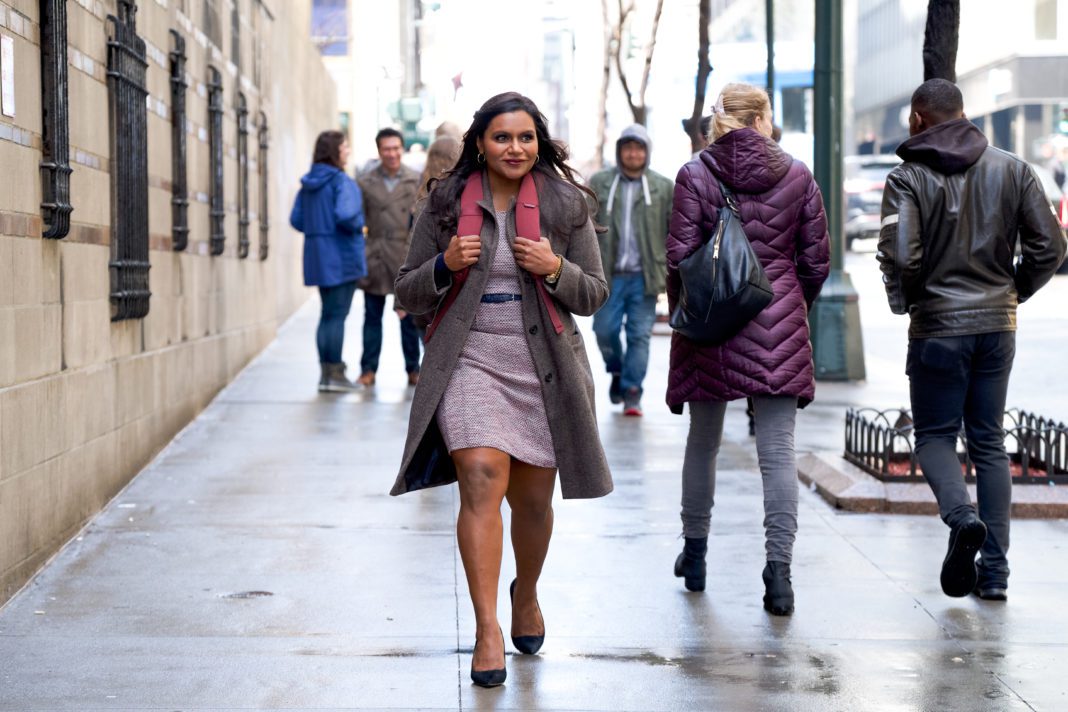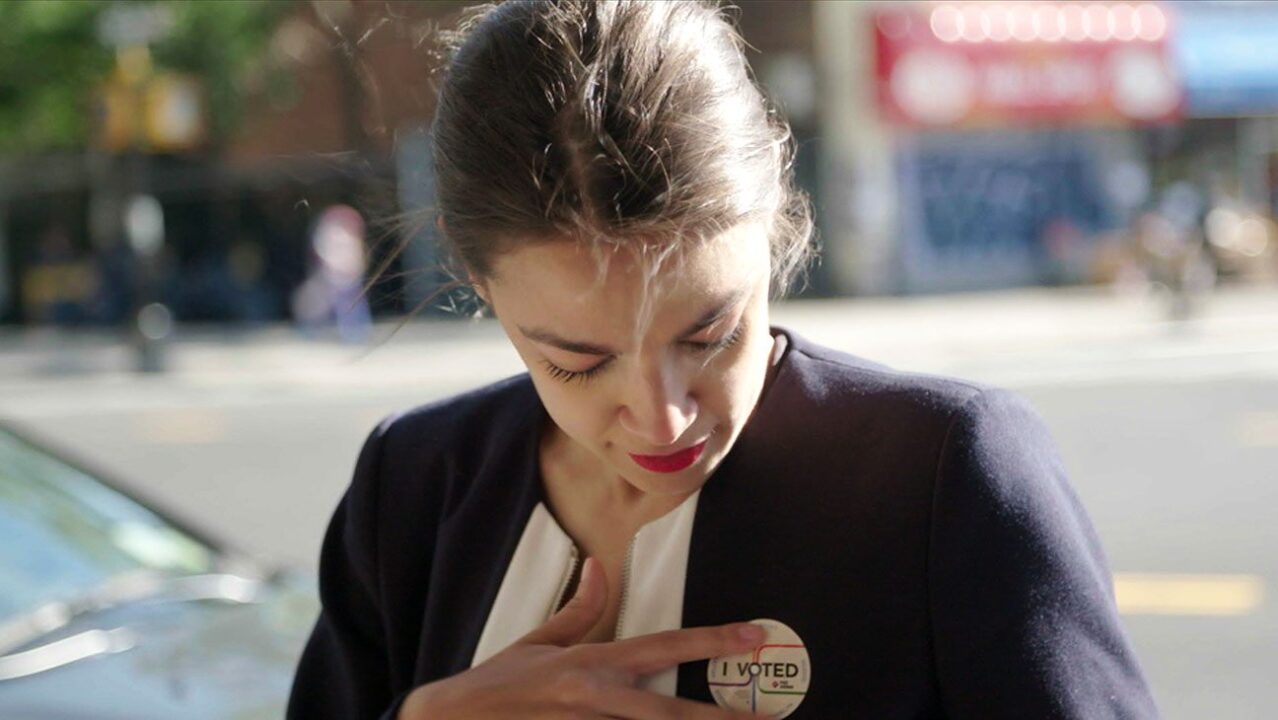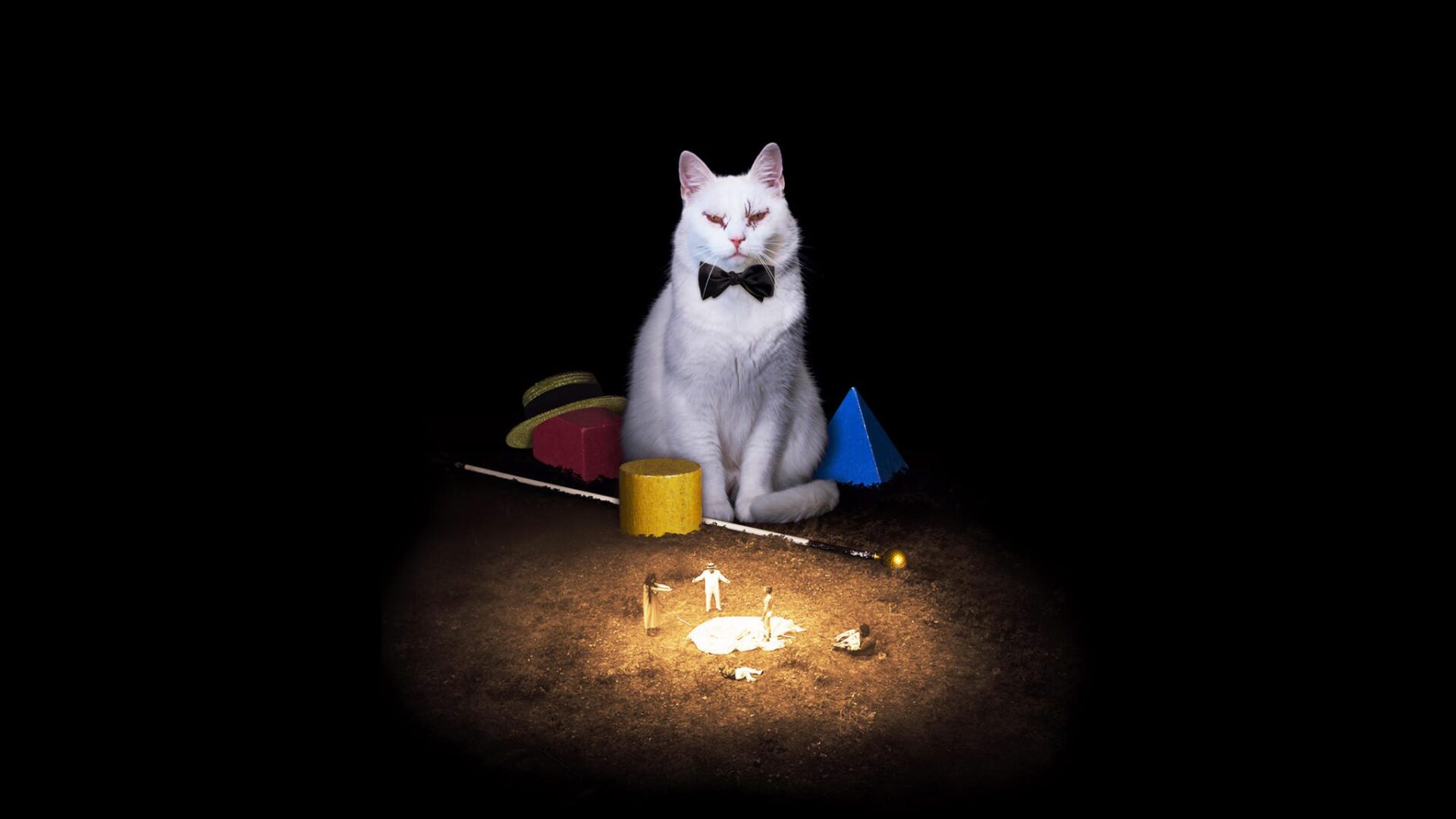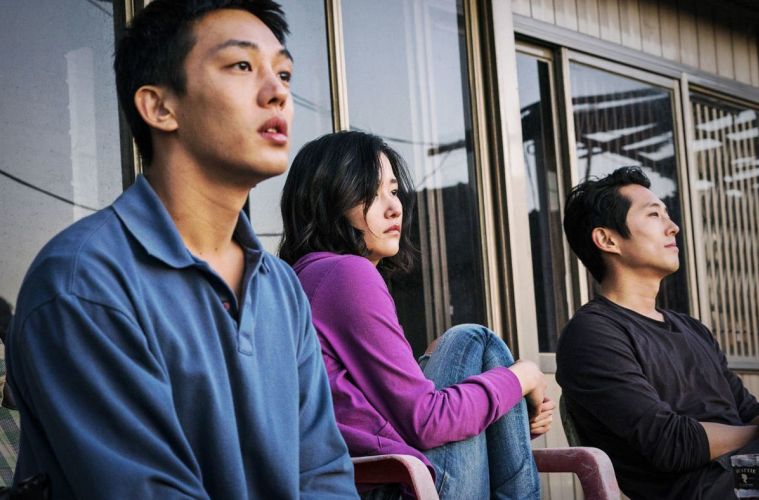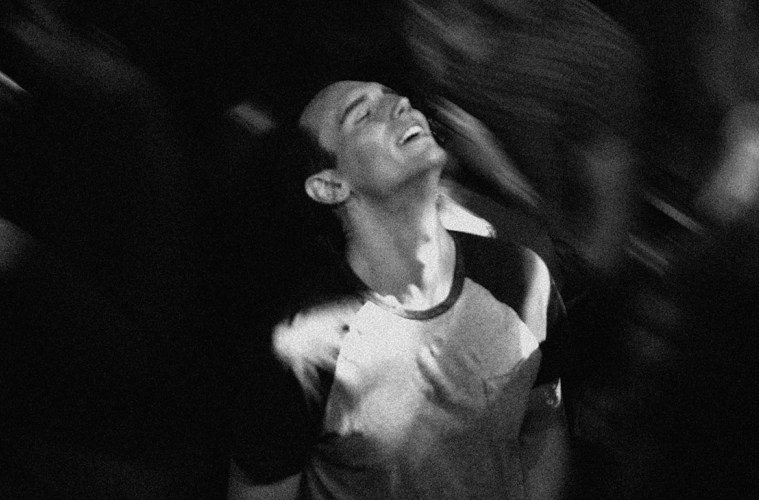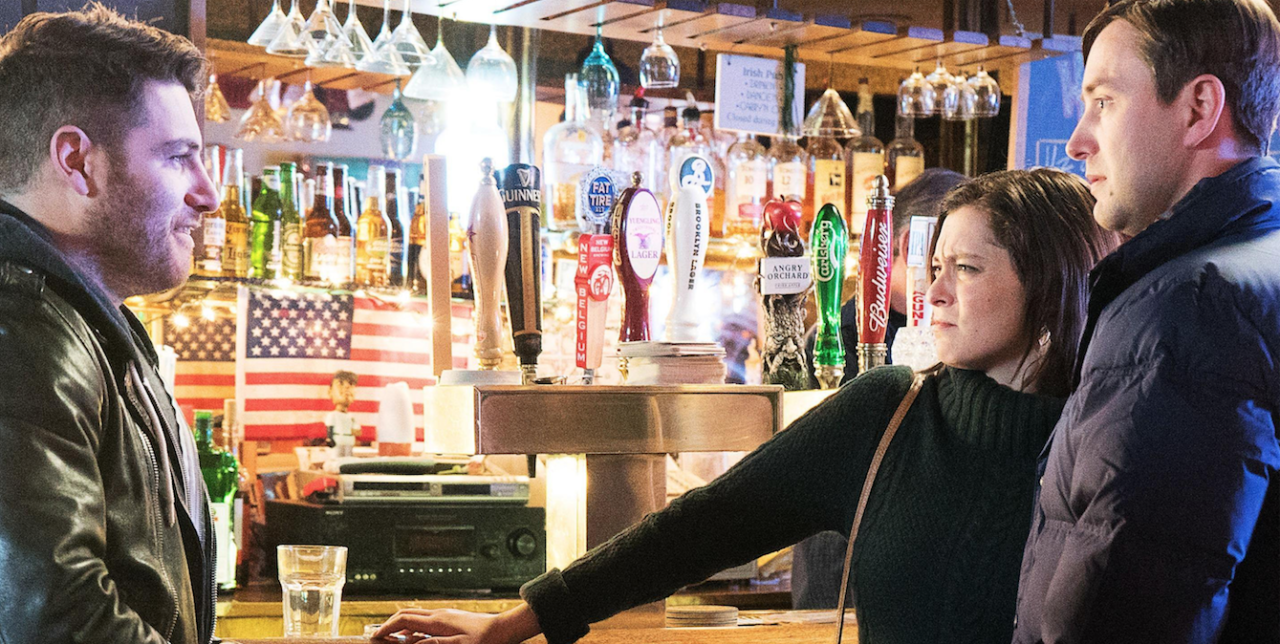Mindy Kaling's 'Late Night' is the New 'The Devil Wears Prada'
LATE NIGHT (2019)
Starring Emma Thompson, Mindy Kaling, John Lithgow
Directed by Nisha Ganatra
Written by Mindy Kaling
Distributed by Amazon Studios. 86 minutes. Opening this Friday at ArcLight Hollywood and The Landmark.
This buzzy Sundance 2019 title finds a bright-eyed Mindy Kaling going up against the steely wit of Emma Thompson. Kaling’s character, Molly Patel, is trying to lock down a writing job at a late night talk show. Unluckily for her, the woman running the show, Katherine Newbury (Emma Thompson) hates mentoring other women. Or anyone, really. Yet, she’s forced to reconsider when called out for the bad optics of staffing only men. This workplace comedy puts questions of diversity and representation at its center, but its commentary proves more blurry than biting.
Late Night finds two (real life) television professionals telling the story of a (fictional) television show. The real-life pros are Mindy Kaling and Nisha Ganatra. Kaling is the film’s screenwriter and star and has been celebrated for her work writing and starring in The Office and The Mindy Project. Director Nisha Ganatra, meanwhile, has lent her directorial talent to a bevy of well-loved shows, from Brooklyn-99 to Fresh Off the Boat, and Dear White People.
The depth of insight these two creators have into the details of television production makes the lack of focus in their critique of the industry all the more disappointing. This comedy is a witty and welcoming watch, but messy characterization choices pile up from the word "go".
It’s such a cliché to say “There is a great film hiding in this good film!” But in the case of Late Night, it feels all too true. The great film hidden in this film is a dual-lead story of two women, a legend whose fame has made her complacent, and a nobody who’s hungry and fresh enough to save the icon’s career while starting her own. As they meet, clash, and collaborate, they decisively illustrate how gendered and racial inequalities persist because of an institutional lack of access and mentorship, not some biological lack of talent or worth.
The Late Night we got bears enough resemblance to that film to make it well worth a watch, but so many go-nowhere side-plots are tacked on that it feels more like a double-length pilot episode than a film. For instance, once Mindy Kaling’s character gets a fairytale opportunity to join Newbury’s writing staff with no prior experience, she’s introduced to Newbury’s team of boyish men who run the slacker-filled writer’s room. A couple of men are set up as romantic interests and part of your brain is like “Okay, he’s a bit bland and I forget his name but I bet they’ll figure him out by the end of season one!” But then there’s no season one because it’s a film and you say to yourself, “Why was the central dynamic between these two women under-served while precious screen-time was given over to pointless, stalling romantic hurdles?”
Still, while there are not nearly enough scenes of them together, the fictional professionals Ganatra and Kaling have imagined are compelling figures. Thompson dazzles as Katherine Newbury, a late night host with decades of experience who is resting on her laurels so hard that she shrugs off the quality drop in her material. Newbury’s internal fire is re-lit only when the network has the gall to threaten to fire her from the show she built. She becomes fixated on the idea that “They can’t fire you if everyone loves you” and it occurs to her that the eager, new Indian-American writer on her staff may help her become relevant again.

Kaling’s screenwriting is at its strongest when she’s establishing Newbury’s dimensions. The film’s first act introduces Newbury as an absolute icon who wears sharp suits, wields cutting remarks, and warms to very few of her underlings. And wherever the material takes her, Thompson can convince you of just about anything.
That said, some of the script’s contrivances with her character stretch credibility. For instance, it’s posited in the first 10 minutes that Newbury has a huge problem with women on her writing staff, making sure every woman is fired within months. However, 10 minutes after that it’s revealed that Newbury hasn’t paid attention to her writing staff in decades. She never allows them on her sets and when she meets them she doesn’t know anyone’s name, instead numbering them like an elementary school teacher counting off groups.
So, which is it? Is Newbury so involved and competitive about meeting other driven women that her hiring influence makes sure they aren’t staffed? Or is she so ensconced in her own reputation that she doesn’t even notice the names on the scripts she received? A big joke is that Newbury has been so detached from the goings on of her staff that she didn’t notice when a writer whose material she loved died years ago from cancer. But at the same time, she’s been specifically naming names of women she wants fired? It would be useful to understand this workplace dynamic and the roots of this pattern since our co-lead, Molly Patel, is about to enter the arena, but no. The inner workings of Katherine’s firing of women remain a mystery.
Kaling’s character is similarly full of weird contradictions in what we’re told and what we’re shown. The idea for her character is sweet and subversive on paper. Kaling is a chemical plant worker who loves comedy but her only opportunity to participate in it is over the plant intercom to her captive audience of co-workers. She supports the local comedy scene but doesn’t think she has a hope of making it until she manages an interview at Newbury’s show because they’re desperate.
This could be a wonderful exploration of the economic obstacles that limit voices in the creative fields, but that point is not well-emphasized. Kaling’s character is a bit too broadly happy-go-lucky for my tastes. She doesn’t have writing samples and, when she’s hired as a writer instead of, you know, writing, she buys donuts and makes a list of criticisms of the show so far. When she’s called out for not brainstorming more suggestions, she breaks down.
It’s a series of weird choices that are amusing enough in the moment, but ultimately undercut the film’s insistence that Kaling is a savvy, hard worker who’s spent her life dreaming of this. She doesn’t deserve The Devil Wears Prada treatment she receives. No one would, but she’s cartoonishly unprepared in a way that makes it hard to fully invest in her meteoric rise.
But that’s enough complaining. I’m glad this film exists and I wish it success, it’s just so much less memorable and tightly-scripted than it might have been with a few more drafts. Still, there are small grace notes and laughs to appreciate. I love the portrayal of the absurd, everyday racism Molly faces, like when her co-workers look at her name and believe they should exoticize its pronunciation into an exaggerated “MAH-LI”. I also appreciate Katherine’s journey towards gratitude for the power and privileges of her public role.
Kaling and Ganatra are such established and proven talents in television, I’m hopeful this film will find mainstream success that allows them to write, direct, and support ever more daring projects. But in the books eventually written about their storied careers, this feels like it will be a stepping stone, not a major entry.
'Knock Down the House' Documents the Rise of Alexandria Ocasio-Cortez
KNOCK DOWN THE HOUSE (2019)
Starring Alexandria Ocasio-Cortez, Cori Bush, Joe Crowley
Directed by Rachel Lears
Written by Robin Blotnick, Rachel Lears
86 minutes. Rated PG. Now streaming on Netflix.
Knock Down the House had its world premiere at the 2019 Sundance Film Festival, where it earned a standing ovation, took home the Audience Award in the U.S. Documentary category, and landed the biggest deal in Sundance documentary history, with a $10 million dollar purchase by Netflix. Here’s what you need to know.
Spotlight on: Alexandria Ocasio-Cortez
Low-budget and born of energy and insistence, Knock Down the House has a great deal in common with the under-dog political candidates it profiles. This brisk, 86-minute documentary tracks the campaigns of 4 Democratic women running for the United States Congress in 2018. Of the four, only one wins her race. I’m referring, of course, to Alexandria Ocasio-Cortez, the now iconic Democratic Socialist who unseated 10-term Democratic incumbent Joe Crowley to become, at 29, the youngest woman to ever serve in the U.S Congress.
These candidates are under-dogs not only because they are women, or because they are first-time candidates, but because they are not independently wealthy and will not accept funds from corporate PACS. They reject the premise that to win political office, a candidate must possess corporate ties that allow them to mount multi-million dollar campaigns. If enough of them are elected, they intend to enact earth-shattering reforms of corporate control in our political system.
Political outsiders
Each candidate was a political outsider, offering a new mold for who can become an elected official. Alexandria Ocasio-Cortez of New York City was pulling shifts as a bartender and waitress to support her family. Cori Bush of Ferguson, Missouri was a nurse and pastor drawn further into politics by the shooting of Michael Brown and ensuing protests against police brutality. Amy Vilela of Las Vegas, Nevada was a working mother motivated to advocate for affordable health care after her daughter died of a preventable condition. Finally, Paula Jean Swearengin of West Virginia was an activist outraged by the human and environmental abuse of the coal industry. In her community, Swearengin has an encyclopedic knowledge of which families have been affected by the soaring, rates of childhood and adult cancers in the mining-heavy mountain towns.
2018 was a historic year for women in politics
You might think it’s unfortunate for the documentary’s narrative that only one of its profiled candidates made it to Congress. However, Lear’s subjects make the cogent case that this is an outcome that must be acknowledged and braced for and that losses play as much a role in the Democratic process as victories, if not more. For every woman who makes it through to Congress, hundreds try. And each that tries her hand builds the infrastructure, energy, and sense of normalization that allows women to govern in a system still defined by un-representative, imbalanced male majorities.
After all, the historic election cycle of 2018 saw 109 women seated in the U.S. House of Representatives. While easily the highest number in United States history, this still represents only 25% of House seats. The film’s choice to follow all Democrats to portray the increased presence of women in office is motivated by political realities also. Of the women seated in the 2019 House of Representatives, 87.3% are Democrats.
In one of the film’s most energizing moments, Cortez encapsulates this persistence in a single sentence, as she offers her young niece some advice. Cortez explains, “For every 10 rejections, you get one acceptance. And that’s how you win everything.”
Female power in front of and behind the scenes
Director Rachel Lears emulates this dogged, never give up attitude. Working on a shoe-string budget cobbled together from grants and a modest Kickstarter campaign, Lears often pulled double or triple duty as she traveled the country getting to know these women, their histories, and their campaigns. She was the director, but also often the cinematographer, cameraperson, and producer.
The rush to prep the film for a Sundance Film Festival premiere shows through a bit in the structure, which lurches between the four candidates, trying to do each justice. And the final product has a pronounced lean towards the magnetic oratory, sincere resolve, and unlikely ascendancy of Alexandria Ocasio-Cortez. One wonders if, with Netflix on board to distribute, we will ever see an expanded edition or a sequel. But for the moment, this serves as a quick and impassioned document of the women who are hurling themselves at elected office with the urgency that this era of economic inequality, environmental collapse, and social upheaval asks of them. They are cracking the glass nationwide and slipping through. They are ready to serve.
8/10
This review originally ran on February 12, 2019, during the Sundance Film Festival
'Koko-di Koko-da' Review: Trapped in a Twisted Fairy Tale
Grief is a gravitational force.
That’s the concept behind Johannes Nyholm’s gruesome fairy tale drama Koko-di Koko-da. In this idea-driven surrealist fable, the grief of a married couple bends their experience of time and space so thoroughly that it summons a band of twisted fairytale villains who entrap the pair in a time loop. Fans of surreal, psychological horror will delight in this film’s intellectual heft, cheerfully sadistic villains, and focused emotional center. Although, many may find that the film's ruthless, psycho-sexual torments make it more of a dark thesis to appreciate than a favorite flick to revisit.
The terror at the heart of Nyholm’s film is a soul-shaking one. It’s the fear of becoming so deadened by depression that you never wake up or fight back, sleeping through seasons and withdrawing into the belief that life will never be vibrant again. This is absolutely how the once happily married Elin and Tobias feel after a tragic event that I won’t spoil, and the supernatural spookiness that descends reflects their inability to escape their own tortured thoughts.
A woodland getaway gets violent
Elin (Ylva Gallon) and Tobias (Leif Edlund) venture into the woods for a healing vacation, but instead are faced with humiliation at the hands of a cheerfully sadistic showman in a white suit. He is the maestro of a woodsy murder crew and his assistants include a gun-wielding woman in a ragged dress, a massive man who loves to body slam, a vicious hound, and the snow-white cat that heralds their approach. They’ve come to torture Elin and Tobias and waste no time massacring the pair.
However, when the torture is finished and Elin and Tobias lay dead, the scene resets so they can be murdered every day in gruesome and undignified ways. Elin and Tobias are clueless as to how to escape but slowly gain awareness that something is wrong. You see, though Koko-di Koko-da has much in common with other time-loop narratives, from Edge of Tomorrow to Russian Doll, its key departure is that the characters don’t retain their memories of the loop. Rather they have a dreamlike sense of unease that increases in clarity with each repetition.
Like the goth Uncle of Groundhog Day
This time-loop premise makes for a smart and eerie journey into the way pain distorts perception. In one of the film’s most unsettling scenes, Elin wakes up alone in the tent and emerges to find wintry snow has set in. As far as we know, this camping trip takes place in the summer. The frightening implication is that the couple will sleep through the rest of their lives, never regaining a healthy engagement with the passage of time. They’ll be frozen in trauma, literally.
However, like most time-loop stories there is the hope of escape from the damaging patterns that hold the characters back. In the small, but strangely excellent little genre of time-loop narratives, it’s common for frustrated characters to examine their life anew, searching for the inflection points where they can make small changes with cascading effects.
Onscreen psycho-sexual abuse will divide audiences
Koko-di Koko-da, in its own warped way, also sees its characters seeking a better life. However, I found the journey didn’t quite fulfill the emotional potential of its premise. Koko-di Koko-da spends so much of its 82 minutes having the leads torn apart by dogs or shot which effectively gets their pain across but gives the capable actors little to do besides whimper. Most troublingly, the time loop always resets on the sexual abuse of the female lead. Sexual assault is held over the male lead as a threat, but never actually shown onscreen.
This is a common double-standard in horror. Many filmmakers seem comfortable showing women being suggestively tortured, but they shy away from being nearly so graphic with male bodies. Now, the sometimes sexual nature of the horror for both characters in Koko-di Koko-da does have a very strong thematic justification and is not meant to be arousing or exploitative, but it crosses a line to a place that many viewers will not want to follow. This element dragged the film down considerably in my estimations, as much as I admired its other ambitions.
Thoughtful horror
On the whole, Koko-di Koko-da is thoughtful horror with an undeniable commitment to expressing emotion visually. It shares so many traits with the best of the horror and time loop genres and earns bonus points for the shadow-puppet animations that appear at key turns in the story. I will never dislike an emotion-centric horror film with animated interludes and a scary cat, but as much as this is, *ahem*, extremely my sh*t, it’s not quite as well-paced, sensitive, or impactful as it could have been. Nevertheless, I hope this isn’t Swedish writer-director Johannes Nyholm’s last trip into the woods, as he clearly grasps what makes a person shiver to their core.
7/10
Koko-di Koko-da has been acquired by U.K. distributor, Picturehouse
'Ask Dr. Ruth' Review: This 90-year-old Offers More Than Just Sex Advice
‘Ask Dr. Ruth’ had its world premiere at the 2019 Sundance Film Festival and will be released online and in theaters by Hulu and Magnolia Pictures this May. Check out the trailer here. Here’s what you need to know.
Dr. Ruth Finds Decency in Indecent Times and Topics
Since the 1980s, Dr. Ruth Westheimer has been answering Americans’ most intimate questions. While some would label her work indecent, this new documentary about her life is a grand tribute to human decency. Through interviews, simple but expressive animations, and archival footage, Dr. Ruth chronicles ninety years of displacement, endurance, good humor, and implacable energy.
Dr. Ruth was a sensationally popular radio and television personality in the 1980s and 90s who brought sex positivity to audiences of millions. She was an improbable superstar. A 4’ 7’’ German-Jewish immigrant who was already well into middle-age when she hosted her first radio series, Sexually Speaking, Ruth had rarely sought or been offered the spotlight. In fact, she spent much of her life on the margins, persisting in face of complete uncertainty of what country she would live in, what education she could receive, and what, if any, of her family she would see again. As much as the documentary celebrates her storied career and advocacy for women, it is equally interested in documenting the full scope of her life, before those latter years of fame.
Although the film has a light hand about it, following the now elderly Ruth as she tours the globe, praises her grandchildren, and prepares yet more books for publication, there’s an obvious interest in documenting the historical lessons of Ruth’s life. Particularly, the way Ruth’s experience of the Holocaust informed her refusal to dehumanize gay men during the AIDS crisis, modern refugees seeking asylum in America, or other groups marginalized by those in power.
A Simple but Stylish Journey Through 90 Years of Striving
Born to a Jewish family in 1928 in Frankfurt, Germany, Ruth was an immigrant and refugee who escaped the Nazi genocide. Ruth does not self-identify as a survivor because, unlike her murdered family, she avoided the camps. This was thanks to a school in Switzerland where Ruth, the child of a loving family who valued education, was given a chance at survival by serving as a maid. Ruth lived as a second-class citizen through her childhood and teenage years in this Alpine town, saving and preserving each letter she received from her family trapped in Germany.
The painterly animations the film uses to portray this era are simple and largely still, but have a transporting effect, providing some idea of the landscapes young Ruth found herself in while allowing us time to ponder and imagine her world as Ruth’s voice-over, often drawn from letters written in her childhood, recounts the events.
Refugee, Scholar, Soldier, Star
Both lively and mournful, the film captures Ruth’s first loves, marriages, time as a soldier in Israel, single motherhood, and boundless commitment to education. After receiving abbreviated schooling in Switzerland, Ruth studied at the Sorbonne, which had special accommodations for those who had missed years of education due to WWII. She then earned her master’s in Sociology at Columbia University and worked at Planned Parenthood. All were experiences which paved the way for her eventual career as a sex therapist and radio expert.
Like RBG and Won’t You Be My Neighbor before it, Dr. Ruth slots comfortably into the popular trend of earnest documentaries that tell you about a person who persisted and found a place to express their humanistic ideals. There is a fierce hunger for this kind of fundamentally nice film, and this will be a welcome addition for Baby Boomers nostalgic for the sound Dr. Ruth’s frank, non-judgmental, German-accented advice. It should also reach younger generations curious about how a WWII-era refugee remade herself into one of the many founding voices in the sex-positive conversations that abound today.
'Burning': This South Korean Thriller Will Fire You Up
“I don’t know what to write yet. To me… the world is a mystery.”
That’s how Jong-su, the lead of the enigmatic South Korean thriller, Burning, answers when asked about his novel. He’s an under-employed creative writing graduate, a few years out of college with not much to show for it. And folks, I may not have understood every socio-political implication in this film, but at least I got this swell new catchphrase out of it. The next time someone asks me about my plans for my twenties I will definitely channel Jong-su and stare evenly at them while mumbling “I don’t know. To me… the world is a mystery.”
That said, don’t get the impression that this is a gently comedic coming-of-age story. I meant it when I said the socio-political underpinnings here are a tangle. The main plot involves the directionless Jong-su (played by acclaimed Korean film star, Yoo Ah-in) falling into a love triangle with a girl from his hometown and a wealthy playboy. The most pivotal scene involves this young woman dancing topless at sunset through the fields of her hometown at the border of North and South Korea, mimicking the movements of flocking birds, until she collapses while the Korean flag ripples in the background. For many viewers this visually and thematically dense sunset ritual will rank among the most richly interpretable scenes of the year. For others, it may be beautifully shot exploitation, riddled with clichés of the volatile, earthy female whose naked body represents the desire to reconnect with physical reality in a hollow modern world. There are a dozen other interpretations we could emblazon onto her skin. I’m split between the mainstream response crying masterpiece (the film is among the year’s best reviewed) and the small but reasonable backlash saying the thriller raises dazzling ideas but loses them in tropes of tragic girls and obsessed men.
I don’t particularly connect with the film’s bleak vision. And yet I don’t deny that vision’s craftsmanship. Accomplished director Lee Chang-Dong (Poetry, Secret Sunshine) knows just when to mete out information to keep an audience yearning, adding more mysteries and ominous moments to the film’s Jenga-like structure. Much unease stems from the unsatisfied, troubled characters, who all have reasons to tease, manipulate, or harm one another to fulfill their own desires.
I don’t particularly connect with the film’s bleak vision. And yet I don’t deny that vision’s craftsmanship.
The drama begins with a chance meeting. Jong-su runs into his mysterious childhood neighbor, Hae-mi (played with wide-eyed intensity by Jong-Seo Jeon), after she’s been rendered unrecognizable by plastic surgery. She’s a free-spirited presence who sweeps Jong-su into a relationship. She loves to re-invent herself, dancing and speaking with an emotional rawness that Jong-su lacks. The mounting unease that will define the film begins early, with a fumbling sex scene in which Hae-mi tells Jong-su that as kids he would cross the street just to tell her how ugly she was. Jong-su can’t remember this or any of the childhood events Hae-mi recounts.
The plot thickens when Hae-mi travels to Africa to seek a group that teaches people to release the small hunger of life to seek the “Big Hunger” of spiritual meaning. When Hae-mi returns she is not alone. Joining her is the fit and wealthy Ben, played by Steven Yeun (Walking Dead, Sorry to Bother You) in his first Korean-language role. Once this main trio is in place the film bursts with ambiguous rivalries.
Jong-su and Ben are constantly contrasted. Where Jong-so is slouching, Ben is suave. While Jong-su is burdened by his family’s financial troubles, Ben commands vast wealth. When asked, Ben won’t say where he works. Jong-su calls him a Korean Gatsby, ranting: “How does he live like this at his age? Traveling abroad, driving a Porsche, listening to music while cooking pasta.” I will always find it hilarious that when Jong-su lists the most suspicious, unreal aspects of a twenty-something man he includes cooking pasta with music. He seems to believe that Ben is everything insincere while his own connection with Hae-mi is real. Jong-su claims he’s an observer of life’s mysteries rather than a judge, but we watch as his, and our, judgmental, pattern-seeking impulses flare at Ben’s behavior. Before long, Jong-su gets the idea that Ben’s interest in Hae-mi is sinister. Ben says he has never cried and observes Hae-mi’s outbursts and Jong-su’s affections with detached amusement.
Things escalate irreversibly after Hae-mi’s sensual dance in the fields. Jong-su calls her a whore for performing in front of Ben. Hae-mi takes this insult quietly and stops reaching out to Jong-su. Then, a mysterious phone call suggests she’s been attacked. Jong-su launches his own investigation of Ben, who doesn’t show concern about Hae-mi’s absence. This search for evidence drives the last act of the film.
I won’t spoil the conclusion. I’ll only say that the more we watch these characters the less sure we become of them. Are their relationships sincere or transactional? Are their memories honest or unreliable? If creeping dread and haunting mysteries fire you up, you’ll get endless fuel from Burning, though you may never be able to make sense of the charred remains.
'Burning' is not rated. 148 minutes. Opening this Friday at ArcLight Hollywood and Laemmle's Royal Theatre.
'1985' Review: Coming Out and Coming Clean
"Carly, the reason I didn't call you... I went there to start over. I really needed a fresh start. I didn't like my life here...and that’s that."
That's how Adrian (Cory Michael Smith), the main character of Yen Tan’s 1985, explains years of radio silence to his childhood best friend, Carly, a Korean-American comic played with wounded charm by Jamie Chung. Adrian and Carly endured middle and high school together with humor, yet after his move to New York, Adrian ignored her calls. Nevertheless, when he visits home he’s so eager to see her that he drives out at the last minute to her performance. When they meet she can sense something off in his halting answers, the way he avoids the details of his life. Angry at his mixed messages, she ends their night out in a fight.
1985 is a film of such unfinished conversations as Adrian, a closeted young man in the midst of the AIDS crisis, ducks and dodges through a tense Christmas visit home. He lost the man he loved and expects he won't survive another year. He plans for all of this baggage to go unsaid to his conservative family. Adrian's aim, which he pursues with wrenching commitment, is gifting his family an idealized goodbye. Yet, if these people love Adrian, we can hope they’ll perceive his pain. The film mines tension from whether, and how, the truth can break free.
Cory Michael Smith (Gotham) shines in the role, capturing the strain of forced cheer as well as the care Adrian holds for those he's compelled to lie to. He's seen familial rejection happen to friends in the LGBTQ community and has done his own calculus. He chooses to mask himself in exchange for a peaceful goodbye with family, fearing the truth would crush their support for him.
1985 follows Adrian through this impossibly cruel circumstance, which so many face without society's support, and often with its open hatred. Smith's performance is rich and real when it shows flashes of the confident, joyful Adrian that existed in New York until he lost his partner, and his job, to AIDS. Yet despite strong performances and compelling tensions, the film does struggle with monotony and lack of development.
On the whole, I salute the director, Yen Tan, and his crew for their sweet and mournful approach to a terrible epidemic and I admire their ambition in shooting this on 16mm film.
There is repetition where there should be momentum. The film is mainly a succession of stressful conversations that unfold like a play, with the camera at a distance and the characters sitting awkwardly in restaurant booths and patio furniture. These distant scenes made me long for more from Adrian’s friends and brother, with whom he is more open as a mentor and confidante. Another version of this story might have given one or two relationships more heft rather than spreading itself thin. As it is, the equal time that is given to Adrian’s brother, father, best friend, and mother make each relationship dynamic feel shortchanged, and their outcome harder to invest in.
That said, some scenes are lovely. My favorite is Adrian's late night talk with his mother (Oscar-nominee Virginia Madsen). In the warmest scene of the film, she covertly tells Adrian she didn't vote for Ronald Reagan and didn't tell his father. She speaks with pride about her hopes for an Equal Rights Amendment, inviting her son to talk to her earnestly about the state of the world. Adrian's surprised delight at this unseen side of a parent, who never seemed political before, is very cute.
If only all of the film had that spark and specificity. Other scenes fall into cliché, especially those involving the father’s heavy-handed remarks about his younger son becoming soft, bemoaning how "everything was fine when he played football." As Adrian's father, Dale, Michael Chiklis does his best but the character remains so dull.
On the whole, I salute the director, Yen Tan, and his crew for their sweet and mournful approach to a terrible epidemic and I admire their ambition in shooting this on 16mm film. Structural problems and a slow pace do leave certain character dynamics under-served, but for a film about a character who knows much in his life may go unsaid and unfinished, that’s a fitting narrative flaw to have.
'1985' is not rated. 85 minutes. Opening this Friday at Laemmle's Glendale Theatre.
'Revenge' Review: This Gonzo Rape-Revenge Story Brims With Vibrancy
I don’t have much trust or love for “rape-revenge” storylines, but after Coralie Fargeat’s debut, I would trust her directorial vision to fill any old genre with furious cinematic life.
Revenge spins such pure, expressive visuals that dialogue feels like a garnish. Take, for instance, the introduction of the leading characters. A helicopter occupies the center of the frame, shuttling Richard (Kevin Janssens), a wealthy Frenchman in pristine, fitted clothes, to his desert hideaway. Behind him sits, Jen (Matilda Lutz), decked out in plastic-y sunglasses, a bright pink top, and star earrings. She is, of course, sucking a lollipop.
Richard has a wife, but Jen is an indulgence– what Richard is to Jen is never entirely clear. Jen dreams of L.A., and Richard seems to be a means to that financial end. When they have sex, she offers him pleasure without seeming to ask for her own. And yet, she appears to genuinely enjoy the flirting and dancing. She plans for a weekend with this sugar daddy, but everything is shaken by the early arrival of Richard’s hunting buddies. The group spends a pivotal night drinking and dancing poolside, which sets all their fates in motion.
The sun-drenched neon colors and centered framing in these early scenes create lush, confident, captivating visuals, but eye candy isn’t the point. Like Jen’s performative sexuality, there always seems to be a greater purpose churning under the surface of the aesthetic choices. For instance, the desert house is full of bright pinks and blues, Jen’s favorite colors. In fact, the windows and pool furniture strongly mimic the pink, blue, gold color scheme of her hair, outfits, and accessories. It’s a clever way of implying that, to Richard, who owns the house, Jen is decorative, like a lounge chair, placed there like any appliance. Yet, it could also foreshadow that Jen will take possession of this world and story, as her color scheme dominates the setting.
After seeing Jen dance, Richard’s bros feel she should be as open to them as any other resource provided by Richard. So, one friend chooses to down beer, inhale candy, and swim. The other rapes Jen.
The treatment of sexual assault in this film has earned favorable comparisons to other stories that see an assaulted person enacting violence against those responsible. That is because, unlike, say, Game of Thrones we aren’t treated to lingering, sexualizing shots of the assault itself. The scene is cold, brutal, and disturbing. Jen’s screams are drowned by a NASCAR-style race blaring on the widescreen TV.
When Jen reports her assault to Richard and demands to leave the desert, he responds, “Baby, baby, baby, don’t act like a child.” Okay, I said earlier that the dialogue felt optional because of the film’s visual strengths, but that’s an all-timer. The script contains such unnerving, condescending misogyny, yet it draws dark comedy out the cartoonish self-involvement of the villains.
Jen may be drawn in the cinematic language of a ditzy sex object, but she is canny and perceptive from the start.
Jen may be drawn in the cinematic language of a ditzy sex object, but she is canny and perceptive from the start. Her distrust toward Richard after this dismissive language is absolute. She runs and the men pursue. Things escalate and a murder attempt transforms Jen into an avenging force. I won’t spoil the gory details, but the rest of the runtime is consumed with callbacks and mirrors to the violence inflicted on Jen. She turns the abuse against her perpetrators in meaningful, well-chosen ways.
My favorite callback comes when, after shooting a bullet into the stomach of one of the men, the flat-screen TV interrupts his screams with the inane babble of a shopping deals channel called “ShopClubUSA”. It’s a delightfully on the nose reversal of the sports channel that tormented and silenced Jen as she was attacked.
Subtlety is not the dish of the day, but that’s welcome when the sounds, settings, costumes, and framings of this sick dreamscape are so hypnotic. This is an over-the-top, searingly violent film whose gory, action thriller pleasures will satisfy many genre fans.
For me, it’s more fun to parse than to actually watch. Revenge’s desert setting and themes of retribution have earned comparison’s to the celebrated Mad Max: Fury Road, one of my favorite films. That film followed the trapped wives, or “prized breeders”, of a dystopian tyrant as they formed an alliance with a mismatched group of road warriors. Revenge does share some of its strengths, but with significant departures. Fury Road’s tale of revenge and justice-seeking is paired with a humanist strain of solidarity and healing. Revenge is a smaller story, sans the armies and unexpected allies of Fury Road’s world.
Maybe I’m a softie at heart, but Revenge is too gonzo and relentless to be an all-time favorite of mine. Likely I’ll always be ill at ease with rape being the turning point for female characters, with that being the act that turns them into a bad-ass to follow into the desert. I will say this film aims to assert that Jen was always confident and worthwhile, but it’s such an uneasy balance. I’m bothered by how violent ruthlessness can be equated with greatness in stories like this, and femininity can be coded as the dull prologue to later feats of heroics. Revenge aims to temper that pitfall in various ways, such as allowing Jen to retain feminine accessories as an action hero.
I’ll leave you with a few Fargeat quotes from a great interview with Seventh Row, where she discussed what it meant for Jen to show such raw power and competence in a bikini:
“I didn’t want a metaphor where, because she becomes stronger, she starts to cover herself. She has her body, and from the beginning to the end, she can do whatever she wants with it. She is who she is, and she can be strong even if she’s still wearing a bikini and is covered in blood.“
“It was important for me to make the message very clear: she can be as sexy and seductive as she wants, it should never be a problem.”- Carolie Fargeat, director/writer
I’m not going to lie, a large percentage of male directors may alert my suspicions if they insisted women bloodied in bikinis represented the height of empowerment. But Fargeat makes a compelling case. I wouldn’t recommend this to the squeamish, but in the age of a resurgent prominence of rape-revenge plotlines, especially on HBO shows like Game of Thrones and Westworld, stylish films by new voices like Fargeat are essential entrants in the discussion.
'Revenge' is rated R for strong bloody gruesome violence, a rape, sexuality, graphic nudity, drug use and language. 108 minutes. Now playing at AMC Sunset 5 and Laemmle's NoHo 7.
'Most Likely To Murder' Review: This Stoner Murder Mystery Comedy is Thoroughly Okay
Look, if you're considering watching this stoner murder mystery comedy there's a good chance it's because you have fond feelings towards someone involved.
And well, you should. The cast is delightful, and each has built a well of goodwill from past performances, but Most Likely To Murder is a film that exists on that portable goodwill from other projects. You only have to take a look at the film’s bare poster, which foregrounds the main cast rather than any aesthetic or concept, to confirm the creative team knows that.
Each lead is recognizable from a televised critical darling or two. First, there's The Mindy Project's Adam Pally playing attention-thirsty man-child, Billy, whose career has stalled as a bathroom attendant in Las Vegas. When he returns to the town he lorded over in high school, he’s flummoxed to find his former girlfriend, Kara (Crazy Ex-Girlfriend’s Rachel Bloom) has hit it off with town outcast, Lowell, (Mad Men’s Vincent Kartheiser). The two are growing up while Billy is as directionless as ever. So, when Lowell's hermetic mother dies mysteriously, Billy aims to convince Kara that her mild-mannered beau, Lowell, is a troll on a murderous roll. And he has some evidence.
This is the first feature from Dan Gregor, who, like his cast, earned his reputation on television, producing and writing for How I Met Your Mother and Crazy-Ex Girlfriend. This film is a trial balloon for his creative team, a test case for moving between the forms they’ve found success in –television and Youtube shorts– and the untried ground of independent film. I’m biased in favor of these artists prior work, so the question for me became, will this entry in their careers grow my goodwill or squander it?
The answer it turns out is neither. This was a true neutral viewing experience. It’s thoroughly okay. It won’t sink or launch careers, just keep them moving. It’s a humble debut with a few smart flourishes that suggest more ambitious offerings from Gregor in the future.
...In the end, I didn’t find a comedic or emotional thread that elevated the film for me, just nuggets of weird promise here and there...
The plot traffics in tropes, particularly the over-grown high school jock, now a flailing thirty-something, trying to reclaim his glory days. The aim of the creative team, then, becomes to enliven this tired premise with their distinct voice.
They have moderate success. Billy, the main character, is massively un-likable. A bully with a poor-me attitude who avoids reflecting on his past, lies compulsively, and expects his town to fawn over him anyway. However, the film is well aware of his awfulness and delivers a lot of low blows to its lead bro as he sulks around in pajamas, reminiscing about old sex tapes. Be forewarned, there are butt-crack shots as the film doubles down on Billy’s humiliating life. Pally is a game, unselfconscious performer but the editing and scripting of his mishaps can get stale. For me, it crossed the line from cringe comedy to cringe.
The more commendable aspect of the film was the confidence and sexual frankness of Bloom’s character, a former cool girl who didn’t give a shit about anything in high school, now trying to function as an adult. She doesn’t have enough screen time, but she’s more acerbic than the typical imperiled girlfriend character, and her emotions always track as she takes Billy down for his meddling ways.
Still, in the end, I didn’t find a comedic or emotional thread that elevated the film for me, just nuggets of weird promise here and there, like the sub-plot of the pregnant woman revolted by the smell of pears or a scene at a “Jews vs goys” local football game. The gags were mildly funny and the suspense mildly stressful. The character arcs found some emotional heft, but this wasn’t given much breathing room amidst final act twists.
If your fandom of one of the creators compels you to seek out Most Likely To Murder, I won’t discourage you. But it’s optional viewing for a creative crew that have essentials in their past, and, I hope and believe, essentials in their future. Many filmmakers cut their teeth on fare like this, unearthing stylistic and thematic goals gradually. This film didn’t dampen my excitement for their future endeavors, but it’s a pit stop, not the main attraction.
'Most Likely to Murder' is rated R for crude sexual content, language throughout, some graphic nudity and drug material. 90 minutes. Now available on VOD via Lionsgate’s Studio L.

